
Georgakilas, V.; Otyepka, M.; Bourlinos, A. B.; Chandra, V.; Kim, N.; Kemp, C. K.; Hobza, P.; Zboril, R.; Kim, K. S.: “Functionalization of Graphene: Covalent and Non-Covalent Approaches, Derivatives and Applications,” Chem. Reviews (2012) 112(11), 6156-6214,
DOI: 10.1021/cr3000412, IF=45.661.
Abstract - Graphene, the two-dimensional sp2-hybridized carbon, is currently, without any doubt, the most intensively studied material. This single-atom-thick sheet of carbon atoms arrayed in a honeycomb pattern is the world’s thinnest, strongest, and stiffest material, as well as being an excellent conductor of both heat and electricity. It is no wonder that this two-dimensional material is considered, from the application viewpoint, to be even more promising than other nanostructured carbon allotropes, that is, 1-dimensional nanotubes and 0-dimensional fullerenes.
This comprehensive review represents the first complex work covering all modes and methods of graphene functionalization including their classification. The complementary discussion of both experimental and theoretical aspects of graphene functionalization and interaction is presented. The functionalization modes related to chemistry of graphene derivatives (GO, graphane, fluorographene) represent a significant part of the review, which thus considerably exceeds the chemistry of pristine graphene.
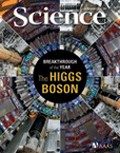 ATLAS Collaboration (Hamal, P.; Nožka, L.): "A Particle Consistent with the Higgs Boson Observed with the ATLAS Detector at the Large Hadron Collider", Science (2012) 338 (6114), 1576-1582,
DOI: 10.1126/science.1232005, IF=31.477.
ATLAS Collaboration (Hamal, P.; Nožka, L.): "A Particle Consistent with the Higgs Boson Observed with the ATLAS Detector at the Large Hadron Collider", Science (2012) 338 (6114), 1576-1582,
DOI: 10.1126/science.1232005, IF=31.477.
Abstract - Nearly 50 years ago, theoretical physicists proposed that a field permeates the universe and gives energy to the vacuum. This field was required to explain why some, but not all, fundamental particles have mass. Numerous precision measurements during recent decades have provided indirect support for the existence of this field, but one crucial prediction of this theory has remained unconfirmed despite 30 years of experimental searches: the existence of a massive particle, the standard model Higgs boson. The ATLAS experiment at the Large Hadron Collider at CERN has now observed the production of a new particle with a mass of 126 giga–electron volts and decay signatures consistent with those expected for the Higgs particle. This result is strong support for the standard model of particle physics, including the presence of this vacuum field. The existence and properties of the newly discovered particle may also have consequences beyond the standard model itself.
 Hobza, P: “Calculations on Noncovalent Interactions and Databases of Benchmark Interaction Energies”, Accounts Chem. Res. (2012) 45, 663-672,
DOI: 10.1021/ar200255p, IF=24.348.
Hobza, P: “Calculations on Noncovalent Interactions and Databases of Benchmark Interaction Energies”, Accounts Chem. Res. (2012) 45, 663-672,
DOI: 10.1021/ar200255p, IF=24.348.
Abstract - Although covalent interactions determine the primary structure of a molecule, the noncovalent interactions are responsible for the tertiary and quaternary structure of a molecule and create the fascinating world of the 3D architectures of biomacromolecules. For example, the double helical structure of DNA is of fundamental importance for the function of DNA: it allows it to store and transfer genetic information. To fulfill this role, the structure is rigid to maintain the double helix with a proper positioning of the complementary base, and floppy to allow for its opening. Very strong covalent interactions cannot fulfill both of these criteria, but noncovalent interactions, which are about 2 orders of magnitude weaker, can. This Account highlights the recent advances in the field of the design of novel wave function theory (WFT) methods applicable to noncovalent complexes ranging in size from less than 100 atoms, for which highly accurate ab initio methods are available, up to extended ones (several thousands atoms), which are the domain of semiempirical QM (SQM) methods.
Accurate interaction energies for noncovalent complexes are generated by the coupled-cluster technique, taking single- and double-electron excitations iteratively and triple-electron excitation perturbatively with a complete basis set description (CCSD(T)/CBS). The procedure provides interaction energies with high accuracy (error less than 1 kcal/mol). Because the method is computationally demanding, its application is limited to complexes smaller than 30 atoms. But researchers would also like to use computational methods to determine these interaction energies accurately for larger biological and nanoscale structures. Standard QM methods such as MP2, MP3, CCSD, or DFT fail to describe various types of noncovalent systems (H-bonded, stacked, dispersion-controlled, etc.) with comparable accuracy. Therefore, novel methods are needed that have been parametrized toward noncovalent interactions, and existing benchmark data sets represent an important tool for the development of new methods providing reliable characteristics of noncovalent clusters.
Our laboratory developed the first suitable data set of CCSD(T)/CBS interaction energies and geometries of various noncovalent complexes, called S22. Since its publication in 2006, it has frequently been applied in parametrization and/or verification of various wave function and density functional techniques. During the intense use of this data set, several inconsistencies emerged, such as the insufficient accuracy of the CCSD(T) correction term or its unbalanced character, which has triggered the introduction of a new, broader, and more accurate data set called the S66 data set. It contains not only 66 CCSD(T)/CBS interaction energies determined in the equilibrium geometries but also 1056 interaction energies calculated at the same level for nonequilibrium geometries. The S22 and S66 data sets have been used for the verification of various WFT methods, and the lowest RMSE (S66, in kcal/mol) was found for the recently introduced SCS-MI-CCSD/CBS (0.08), MP2.5/CBS (0.16), MP2.X/6-31G* (0.27), and SCS-MI-MP2/CBS (0.38) methods. Because of their computational economy, the MP2.5 and MP2.X/6-31G* methods can be recommended for highly accurate calculations of large complexes with up to 100 atoms.
The evaluation of SQM methods was based only on the S22 data set, and because some of these methods have been parametrized toward the same data set, the respective results should be taken with caution. For really extended complexes such as protein–ligand systems, only the SMQ methods are applicable. After adding the corrections to the dispersion energy and H-bonding, several methods exhibit surprisingly low RMSE (even below 0.5 kcal/mol). Among the various SMQ methods, the PM6-DH2 can be recommended because of its computational efficiency and it can be used for optimization (which is not the case for other SQM methods). The PM6-DH2 is the base of our novel scoring function used in in silico drug design.
 Pierre Auger Collaboration (Horváth P.; Hrabovský M.): “Large-scale Distribution of Arrival Directions of Cosmic Rays Detected Above 10(18) eV at the Pierre Auger Observatory”, Astrophys. J. Suppl. Ser. (2012) 203, 34,
DOI: 10.1088/0067-0049/203/2/34, IF=14.137.
Pierre Auger Collaboration (Horváth P.; Hrabovský M.): “Large-scale Distribution of Arrival Directions of Cosmic Rays Detected Above 10(18) eV at the Pierre Auger Observatory”, Astrophys. J. Suppl. Ser. (2012) 203, 34,
DOI: 10.1088/0067-0049/203/2/34, IF=14.137.
Abstract – A thorough search for large-scale anisotropies in the distribution of arrival directions of cosmic rays detected above 10
18 eV at the Pierre Auger Observatory is presented. This search is performed as a function of both declination and right ascension in several energy ranges above 10
18 eV, and reported in terms of dipolar and quadrupolar coefficients. Within the systematic uncertainties, no significant deviation from isotropy is revealed. Assuming that any cosmic-ray anisotropy is dominated by dipole and quadrupole moments in this energy range, upper limits on their amplitudes are derived. These upper limits allow us to test the origin of cosmic rays above 10
18 eV from stationary Galactic sources densely distributed in the Galactic disk and predominantly emitting light particles in all directions.
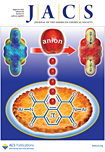 Zeleny, T; Ruckenbauer, M; Aquino, AJA; Muller, T; Lankas, F; Drsata, T; Hase, WL; Nachtigallova, D; Lischka, H: “Strikingly Different Effects of Hydrogen Bonding on the Photodynamics of Individual Nucleobases in DNA: Comparison of Guanine and Cytosine”, J. Am. Chem. Soc. (2012) 134, 13662-13669,
DOI: 10.1021/ja3028845, IF=11.444.
Zeleny, T; Ruckenbauer, M; Aquino, AJA; Muller, T; Lankas, F; Drsata, T; Hase, WL; Nachtigallova, D; Lischka, H: “Strikingly Different Effects of Hydrogen Bonding on the Photodynamics of Individual Nucleobases in DNA: Comparison of Guanine and Cytosine”, J. Am. Chem. Soc. (2012) 134, 13662-13669,
DOI: 10.1021/ja3028845, IF=11.444.
Abstract - Ab initio surface hopping dynamics calculations were performed to study the photophysical behavior of cytosine and guanine embedded in DNA using a quantum mechanical/molecular mechanics (QM/MM) approach. It was found that the decay rates of photo excited cytosine and guanine were affected in a completely different way by the hydrogen bonding to the DNA environment. In case of cytosine, the geometrical restrictions exerted by the hydrogen bonds did not influence the relaxation time of cytosine significantly due to the generally small cytosine ring puckering required to access the crossing region between excited and ground state. On the contrary, the presence of hydrogen bonds significantly altered the photodynamics of guanine. The analysis of the dynamics indicates that the major contribution to the lifetime changes comes from the interstrand hydrogen bonds. These bonds considerably restricted the out-of-plane motions of the NH2 group of guanine which are necessary for the ultrafast decay to the ground state. As a result, only a negligible amount of trajectories decayed into the ground state for guanine embedded in DNA within the simulation time of 0.5 ps, while for comparison, the isolated guanine relaxed to the ground state with a lifetime of about 0.22 ps. These examples show that, in addition to phenomena related to electronic interactions between nucleobases, there also exist relatively simple mechanisms in DNA by which the lifetime of a nucleobase is significantly enhanced as compared to the gasphase.
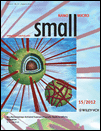 Bakandritsos, A; Papagiannopoulos, A; Anagnostou, EN; Avgoustakis, K; Zboril, R; Pispas, S; Tucek, J; Ryukhtin, V; Bouropoulos, N; Kolokithas-Ntoukas, A; Steriotis, TA; Keiderling, U; Winnefeld, F: “Merging High Doxorubicin Loading with Pronounced Magnetic Response and Bio-repellent Properties in Hybrid Drug Nanocarriers”, Small (2012) 8, 2381-2393,
DOI: 10.1002/smll.201102525, IF=7.514.
Bakandritsos, A; Papagiannopoulos, A; Anagnostou, EN; Avgoustakis, K; Zboril, R; Pispas, S; Tucek, J; Ryukhtin, V; Bouropoulos, N; Kolokithas-Ntoukas, A; Steriotis, TA; Keiderling, U; Winnefeld, F: “Merging High Doxorubicin Loading with Pronounced Magnetic Response and Bio-repellent Properties in Hybrid Drug Nanocarriers”, Small (2012) 8, 2381-2393,
DOI: 10.1002/smll.201102525, IF=7.514.
Abstract- Hybrid magnetic drug nanocarriers are prepared via a self-assembly process of poly(methacrylic acid)-graft-poly(ethyleneglycol methacrylate) (p(MAA-g-EGMA)) on growing iron oxide nanocrystallites. The nanocarriers successfully merge together bio-repellent properties, pronounced magnetic response, and high loading capacity for the potent anticancer drug doxorubicin (adriamicin), in a manner not observed before in such hybrid colloids. High magnetic responses are accomplished by engineering the size of the magnetic nanocrystallites (∼13.5 nm) following an aqueous single-ferrous precursor route, and through adjustment of the number of cores in each colloidal assembly. Complementing conventional magnetometry, the magnetic response of the nanocarriers is evaluated by magnetophoretic experiments providing insight into their internal organization and on their response to magnetic manipulation. The structural organization of the graft-copolymer, locked on the surface of the nanocrystallites, is further probed by small-angle neutron scattering on single-core colloids. Analysis showed that the MAA segments selectively populate the area around the magnetic nanocrystallites, while the poly(ethylene glycol)-grafted chains are arranged as protrusions, pointing towards the aqueous environment. These nanocarriers are screened at various pHs and in highly salted media by light scattering and electrokinetic measurements. According to the results, their stability is dramatically enhanced, as compared to uncoated nanocrystallites, owing to the presence of the external protective PEG canopy. The nanocarriers are also endowed with bio-repellent properties, as evidenced by stability assays using human blood plasma as the medium.
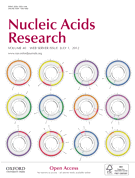 Berka, K; Hanak, O; Sehnal, D; Banas, P; Navratilova, V; Jaiswal, D; Ionescu, CM; Varekova, RS; Koca, J; Otyepka, M: “MOLEonline 2.0: interactive web-based analysis of biomacromolecular channels”, Nucleic Acids Res. (2012) 40, W222-W227,
DOI: 10.1093/nar/gks363, IF=8.808.
Berka, K; Hanak, O; Sehnal, D; Banas, P; Navratilova, V; Jaiswal, D; Ionescu, CM; Varekova, RS; Koca, J; Otyepka, M: “MOLEonline 2.0: interactive web-based analysis of biomacromolecular channels”, Nucleic Acids Res. (2012) 40, W222-W227,
DOI: 10.1093/nar/gks363, IF=8.808.
Abstract - Biomolecular channels play important roles in many biological systems, e.g. enzymes, ribosomes and ion channels. This article introduces a web-based interactive MOLEonline 2.0 application for the analysis of access/egress paths to interior molecular voids. MOLEonline 2.0 enables platform-independent, easy-to-use and interactive analyses of (bio)macromolecular channels, tunnels and pores. Results are presented in a clear manner, making their interpretation easy. For each channel, MOLEonline displays a 3D graphical representation of the channel, its profile accompanied by a list of lining residues and also its basic physicochemical properties. The users can tune advanced parameters when performing a channel search to direct the search according to their needs. The MOLEonline 2.0 application is freely available via the Internet at http://ncbr.muni.cz/mole or http://mole.upol.cz .
 RCPTM members (Hamal, P.; Nozka, L.) have contributed to a number of ATLAS Collaboration articles that form a significant part among the most valued publications of the Centre. Until now, 16 Phys. Rev. Lett. (IF=7.728) papers have been published in 2012 from the areas of the search for the Higgs boson, the search for supersymmetric particles, and the search of other signatures of new physics: extra dimensions/missing energy, micro black holes production, axions etc.
RCPTM members (Hamal, P.; Nozka, L.) have contributed to a number of ATLAS Collaboration articles that form a significant part among the most valued publications of the Centre. Until now, 16 Phys. Rev. Lett. (IF=7.728) papers have been published in 2012 from the areas of the search for the Higgs boson, the search for supersymmetric particles, and the search of other signatures of new physics: extra dimensions/missing energy, micro black holes production, axions etc.
 Pierre Auger Collaboration (Horváth P.; Hrabovský M.): “Measurement of the Proton-Air Cross Section at root s=57 TeV with the Pierre Auger Observatory”, Phys. Rev. Lett. (2012) 109, 62002,
DOI: 10.1103/PhysRevLett.109.062002, IF=7.728.
Pierre Auger Collaboration (Horváth P.; Hrabovský M.): “Measurement of the Proton-Air Cross Section at root s=57 TeV with the Pierre Auger Observatory”, Phys. Rev. Lett. (2012) 109, 62002,
DOI: 10.1103/PhysRevLett.109.062002, IF=7.728.
Abstract - We report a measurement of the proton-air cross section for particle production at the center-of-mass energy per nucleon of 57 TeV. This is derived from the distribution of the depths of shower maxima observed with the Pierre Auger Observatory: systematic uncertainties are studied in detail. Analyzing the tail of the distribution of the shower maxima, a proton-air cross section of [505±22(stat)-36+28(syst)] mb is found.
 Petr, J; Maier, V: “Analysis of microorganisms by capillary electrophoresis”, Trac-Trends Anal. Chem. (2012) 31, 9-22,
DOI: 10.1016/j.trac.2011.07.013, IF=6.612.
Petr, J; Maier, V: “Analysis of microorganisms by capillary electrophoresis”, Trac-Trends Anal. Chem. (2012) 31, 9-22,
DOI: 10.1016/j.trac.2011.07.013, IF=6.612.
Abstract - Microorganisms are well known for their positive, as well as negative, effects on health, which mean that there is a great need for methods of discovery, identification and determination of microorganisms. In the past decade, capillary electrophoresis (CE) began to be an interesting tool for analysis of microorganisms, interestingly sometimes with similar dimensions for the separation capillary and the microorganisms.
This review focuses on the use of CE in the analysis of microorganisms. First, it looks at the origin of microbial surface charge and then describes key points in the analysis of microbes by capillary zone electrophoresis [first approaches using poly(ethylene oxide), covalent modification of the inner capillary wall, reversed electroosmotic flow, advances in detection, and on-line preconcentration] and capillary isoelectric focusing.
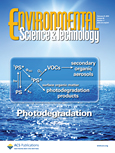 Marsalek, B; Jancula, D; Marsalkova, E; Mashlan, M; Safarova, K; Tucek, J; Zboril, R: “Multimodal Action and Selective Toxicity of Zerovalent Iron Nanoparticles against Cyanobacteria”, Environ. Sci. Technol. (2012) 46, 2316-2323,
DOI: 10.1021/es2031483, IF=5.481.
Marsalek, B; Jancula, D; Marsalkova, E; Mashlan, M; Safarova, K; Tucek, J; Zboril, R: “Multimodal Action and Selective Toxicity of Zerovalent Iron Nanoparticles against Cyanobacteria”, Environ. Sci. Technol. (2012) 46, 2316-2323,
DOI: 10.1021/es2031483, IF=5.481.
Abstract - Cyanobacteria pose a serious threat to water resources around the world. This is compounded by the fact that they are extremely resilient, having evolved numerous protective mechanisms to ensure their dominant position in their ecosystem. We show that treatment with nanoparticles of zerovalent iron (nZVI) is an effective and environmentally benign method for destroying and preventing the formation of cyanobacterial water blooms. The nanoparticles have multiple modes of action, including the removal of bioavailable phosphorus, the destruction of cyanobacterial cells, and the immobilization of microcystins, preventing their release into the water column. Ecotoxicological experiments showed that nZVI is a highly selective agent, having an EC50 of 50 mg/L against cyanobacteria; this is 20–100 times lower than its EC50 for algae, daphnids, water plants, and fishes. The primary product of nZVI treatment is nontoxic and highly aggregated Fe(OH)3, which promotes flocculation and gradual settling of the decomposed cyanobacterial biomass.

 ATLAS Collaboration (Hamal, P.; Nožka, L.): "A Particle Consistent with the Higgs Boson Observed with the ATLAS Detector at the Large Hadron Collider", Science (2012) 338 (6114), 1576-1582,
DOI: 10.1126/science.1232005, IF=31.477.
ATLAS Collaboration (Hamal, P.; Nožka, L.): "A Particle Consistent with the Higgs Boson Observed with the ATLAS Detector at the Large Hadron Collider", Science (2012) 338 (6114), 1576-1582,
DOI: 10.1126/science.1232005, IF=31.477. Hobza, P: “Calculations on Noncovalent Interactions and Databases of Benchmark Interaction Energies”, Accounts Chem. Res. (2012) 45, 663-672,
DOI: 10.1021/ar200255p, IF=24.348.
Hobza, P: “Calculations on Noncovalent Interactions and Databases of Benchmark Interaction Energies”, Accounts Chem. Res. (2012) 45, 663-672,
DOI: 10.1021/ar200255p, IF=24.348. Pierre Auger Collaboration (Horváth P.; Hrabovský M.): “Large-scale Distribution of Arrival Directions of Cosmic Rays Detected Above 10(18) eV at the Pierre Auger Observatory”, Astrophys. J. Suppl. Ser. (2012) 203, 34,
DOI: 10.1088/0067-0049/203/2/34, IF=14.137.
Pierre Auger Collaboration (Horváth P.; Hrabovský M.): “Large-scale Distribution of Arrival Directions of Cosmic Rays Detected Above 10(18) eV at the Pierre Auger Observatory”, Astrophys. J. Suppl. Ser. (2012) 203, 34,
DOI: 10.1088/0067-0049/203/2/34, IF=14.137. Zeleny, T; Ruckenbauer, M; Aquino, AJA; Muller, T; Lankas, F; Drsata, T; Hase, WL; Nachtigallova, D; Lischka, H: “Strikingly Different Effects of Hydrogen Bonding on the Photodynamics of Individual Nucleobases in DNA: Comparison of Guanine and Cytosine”, J. Am. Chem. Soc. (2012) 134, 13662-13669,
DOI: 10.1021/ja3028845, IF=11.444.
Zeleny, T; Ruckenbauer, M; Aquino, AJA; Muller, T; Lankas, F; Drsata, T; Hase, WL; Nachtigallova, D; Lischka, H: “Strikingly Different Effects of Hydrogen Bonding on the Photodynamics of Individual Nucleobases in DNA: Comparison of Guanine and Cytosine”, J. Am. Chem. Soc. (2012) 134, 13662-13669,
DOI: 10.1021/ja3028845, IF=11.444. Bakandritsos, A; Papagiannopoulos, A; Anagnostou, EN; Avgoustakis, K; Zboril, R; Pispas, S; Tucek, J; Ryukhtin, V; Bouropoulos, N; Kolokithas-Ntoukas, A; Steriotis, TA; Keiderling, U; Winnefeld, F: “Merging High Doxorubicin Loading with Pronounced Magnetic Response and Bio-repellent Properties in Hybrid Drug Nanocarriers”, Small (2012) 8, 2381-2393,
DOI: 10.1002/smll.201102525, IF=7.514.
Bakandritsos, A; Papagiannopoulos, A; Anagnostou, EN; Avgoustakis, K; Zboril, R; Pispas, S; Tucek, J; Ryukhtin, V; Bouropoulos, N; Kolokithas-Ntoukas, A; Steriotis, TA; Keiderling, U; Winnefeld, F: “Merging High Doxorubicin Loading with Pronounced Magnetic Response and Bio-repellent Properties in Hybrid Drug Nanocarriers”, Small (2012) 8, 2381-2393,
DOI: 10.1002/smll.201102525, IF=7.514. Berka, K; Hanak, O; Sehnal, D; Banas, P; Navratilova, V; Jaiswal, D; Ionescu, CM; Varekova, RS; Koca, J; Otyepka, M: “MOLEonline 2.0: interactive web-based analysis of biomacromolecular channels”, Nucleic Acids Res. (2012) 40, W222-W227,
DOI: 10.1093/nar/gks363, IF=8.808.
Berka, K; Hanak, O; Sehnal, D; Banas, P; Navratilova, V; Jaiswal, D; Ionescu, CM; Varekova, RS; Koca, J; Otyepka, M: “MOLEonline 2.0: interactive web-based analysis of biomacromolecular channels”, Nucleic Acids Res. (2012) 40, W222-W227,
DOI: 10.1093/nar/gks363, IF=8.808. RCPTM members (Hamal, P.; Nozka, L.) have contributed to a number of ATLAS Collaboration articles that form a significant part among the most valued publications of the Centre. Until now, 16 Phys. Rev. Lett. (IF=7.728) papers have been published in 2012 from the areas of the search for the Higgs boson, the search for supersymmetric particles, and the search of other signatures of new physics: extra dimensions/missing energy, micro black holes production, axions etc.
RCPTM members (Hamal, P.; Nozka, L.) have contributed to a number of ATLAS Collaboration articles that form a significant part among the most valued publications of the Centre. Until now, 16 Phys. Rev. Lett. (IF=7.728) papers have been published in 2012 from the areas of the search for the Higgs boson, the search for supersymmetric particles, and the search of other signatures of new physics: extra dimensions/missing energy, micro black holes production, axions etc. Pierre Auger Collaboration (Horváth P.; Hrabovský M.): “Measurement of the Proton-Air Cross Section at root s=57 TeV with the Pierre Auger Observatory”, Phys. Rev. Lett. (2012) 109, 62002,
DOI: 10.1103/PhysRevLett.109.062002, IF=7.728.
Pierre Auger Collaboration (Horváth P.; Hrabovský M.): “Measurement of the Proton-Air Cross Section at root s=57 TeV with the Pierre Auger Observatory”, Phys. Rev. Lett. (2012) 109, 62002,
DOI: 10.1103/PhysRevLett.109.062002, IF=7.728. Petr, J; Maier, V: “Analysis of microorganisms by capillary electrophoresis”, Trac-Trends Anal. Chem. (2012) 31, 9-22,
DOI: 10.1016/j.trac.2011.07.013, IF=6.612.
Petr, J; Maier, V: “Analysis of microorganisms by capillary electrophoresis”, Trac-Trends Anal. Chem. (2012) 31, 9-22,
DOI: 10.1016/j.trac.2011.07.013, IF=6.612. Marsalek, B; Jancula, D; Marsalkova, E; Mashlan, M; Safarova, K; Tucek, J; Zboril, R: “Multimodal Action and Selective Toxicity of Zerovalent Iron Nanoparticles against Cyanobacteria”, Environ. Sci. Technol. (2012) 46, 2316-2323,
DOI: 10.1021/es2031483, IF=5.481.
Marsalek, B; Jancula, D; Marsalkova, E; Mashlan, M; Safarova, K; Tucek, J; Zboril, R: “Multimodal Action and Selective Toxicity of Zerovalent Iron Nanoparticles against Cyanobacteria”, Environ. Sci. Technol. (2012) 46, 2316-2323,
DOI: 10.1021/es2031483, IF=5.481.